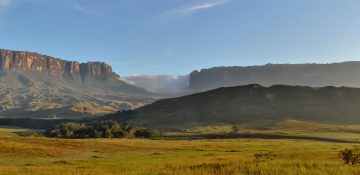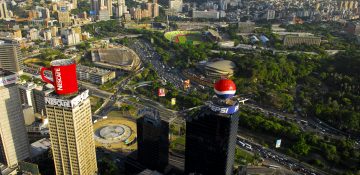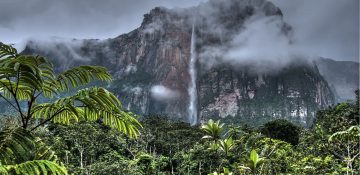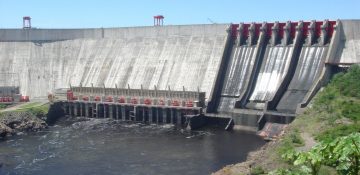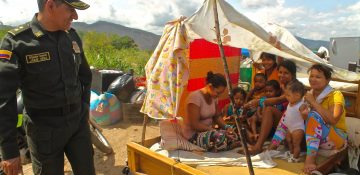A
Active Layer
A part of the soil which usually freezes in winter and thaws in summer, it can also be known as frost zone.
Adaptation
The process of adjustment to actual or expected climate and its effects. In human systems, adaptation seeks to moderate harm or exploit beneficial opportunities. In natural systems, human intervention may facilitate adjustment to expected climate and its effects.
Aerosols
A suspension of airborne solid or liquid particles, with a typical size between a few nanometres and 10 μm that reside in the atmosphere for at least several hours.
Afforestation
Planting of new forests on land that has not recently been wooded.
Air Conditioning
The cooling of air inside buildings to produce a comfortable temperature and humidity. This can be done using a heat pump, as in a fridge, or using natural means such as passing water through walls.
Albedo
The fraction of solar radiation reflected by a surface or object, often expressed as a percentage. Snow-covered surfaces have a high albedo, the albedo of soils ranges from high to low, and vegetation-covered surfaces and oceans have a low albedo. The Earth’s planetary albedo varies mainly through varying cloudiness, snow, ice, leaf area and and cover changes.
Anthropogenic
Resulting from human activity, often called “man-made` or “human-caused”
Anthropogenic Emissions
Emissions of greenhouse gases and other pollutants as a result of human activities such as burning fossil fuels for energy and deforestation.
AR4
The 4th Assessment Report of the IPCC, published in 2007. The 4AR was superseded by the 5th Assessment report, published in 2013/ 2014, on which this update booklet is based.
Archipelago
A chain, cluster or arc of islands, sometimes formed by volcanic action.
Atmosphere
An envelope of gases surrounding the Earth. The main gases are nitrogen and oxygen, with smaller amounts of other gases such as water vapour, carbon dioxide and methane.
Attribution
The process of evaluating the relative contributions of multiple causal factors to a change or event with an assignment of statistical confidence
B
Basin
The drainage area of a stream, river or lake.
Biodiversity
The variation of different life forms in an ecosystem or the planet as a whole.
Biofuel
Any fuel (liquid, solid or gas) produced from organic matter (matter from animals or plants).
Biological pump
The process of transporting carbon from the ocean’s surface layers to the deep ocean by the primary production of marine phytoplankton, which converts dissolved inorganic carbon (DIC), mainly CO2, and nutrients into organic matter through photosynthesis.
Biomass
Organic matter, including living organisms, and dead matter such as wood and leaves.
Biosphere (Terrestrial and Marine)
The part of the Earth system comprising all ecosystems and living organisms in the atmosphere, on land (terrestrial biosphere), or in the oceans (marine biosphere).
C
Capacity Building
In the context of climate change, capacity building is a process of developing the technical skills and resources of people and institutions to enable them to participate in all aspects of adaptation to, mitigation of, and research into, climate change.
Carbon Cycle
The term used to describe the flow of carbon through the atmosphere, land, ocean and biospheres.
Carbon Dioxide (CO2)
A naturally occurring gas, and also a by-product of burning fossil fuels and biomass. It is the principal anthropogenic greenhouse gas that affects the Earth`s climate.
Carbon Footprint
The effect of human activities on the climate in terms of the net quantity of greenhouse gases generated through individual lifestyle choices.
Climate
The average weather, or more rigorously, the statistical description in terms of the mean and variability of relevant quantities over a period of time ranging from months to thousands or millions of years. The classical period for averaging these variables is 30 years, as defined by the World Meteorological Organization. The relevant quantities are most often surface variables such as temperature, precipitation and wind.
Climate Change
A change in the state of the climate that can be identified (e.g., by using statistical tests) by changes in the mean and/or the variability of its properties, and that persists for an extended period, typically decades or longer. Climate change may be due to natural internal processes or external forcings such as modulations of the solar cycles, volcanic eruptions, and persistent anthropogenic changes in the composition of the atmosphere or in land use.
Climate Change Impacts
Consequences of climate change on nature and people, such as rising sea-level.
Climate Feedback
A climate feedback is an initial process in the climate which leads to a change in another process in the climate, which then influences the initial one. There are many feedback mechanisms in the climate system that can either amplify (increase – ‘positive feedback’) or diminish (decrease – ‘negative feedback’) changes in the Earth’s climate.
Climate Impact Assessment
Identifying the consequences of climate change on nature and people, and evaluating how important they are.
Climate Model (Hierarchy)
The numbers and equations that describe the climate system, including the physics, chemistry and biology going on within it, how they interact and affect each other. The most comprehensive models include detailed descriptions of atmosphere, land, oceans, snow and ice and the biosphere, and need powerful supercomputers to be able to use them.
Climate Projection
A projection of the response of the climate system to emissions of greenhouse gases and other pollutants, based upon calculations made by climate models.
Climate System
The climate system is made up of five major components: the atmosphere, the hydrosphere, the cryosphere, the land surface and the biosphere
Climate Variability
Climate variability refers to variations in the average climate from year to year and decade to decade. Variations can be due to many things, including volcanic eruptions and events like the El Niño weather event.
Cryosphere
All regions on and beneath the surface of the Earth and ocean where water is in solid form, including sea ice, lake ice, river ice, snow cover, glaciers and ice sheets, and frozen ground (which includes permafrost).
D
Deforestation
Conversion of forest to non-forest.
Desertification
Reducing the quality and productivity of the land in arid or semi-arid areas. This may be the result of natural climatic variations or human activities.
Detection
Detection of climate change is the process of demonstrating that climate has changed in some way, without providing a reason for that change.
Drought
A period of abnormally dry weather long enough to cause a serious hydrological imbalance. Drought is a relative term; therefore any discussion in terms of precipitation deficit must refer to the particular precipitation-related activity that is under discussion.
E
Ecosystem
A system of interacting living organisms together with their physical environment.
El Niño
A natural warming of the tropical Pacific Ocean east of the dateline, that typically occurs every few years. It has effects throughout the Pacific region and in many other parts of the world. At other times, there may be a cool phase called La Niña.
Emissions
The human-caused release of greenhouse gases and other pollutants.
Emissions Scenario
A plausible representation of the future development of emissions of substances that potentially influence the earth’s energy budget (e.g., greenhouse gases, aerosols) and are based on a coherent and internally consistent set of assumptions about driving forces (such as demographic and socioeconomic development, technological change) and their key relationships.
Energy Budget
The Earth is a physical system with an energy budget that includes all gains of incoming energy and all losses of outgoing energy. The Earth’s energy budget is determined by measuring how much energy comes into the Earth system from the Sun, how much energy is lost to space, and accounting for the remainder on Earth and energy flows between the atmosphere and the ocean or land surface.
Evaporation
The process by which a liquid becomes a gas.
Extreme Weather Event
An extreme weather event is an event that is rare in a specific area or time; typically only on 10% of occasions. These may include heat waves, floods, droughts, hurricanes etc. Single extreme events cannot be attributed to human-caused climate change, as it is possible that the event in question might have occurred naturally.
F
Feedback
An interaction in which a perturbation (change) in one climate quantity causes a change in a second, and the change in the second quantity ultimately leads to an additional change in the first. A negative feedback is one in which the initial perturbation is weakened by the changes it causes; a positive feedback is one in which the initial perturbation is increased. For example, melting ice can expose dark-coloured land. The dark-coloured land absorbs more heat than the white ice, leading to further warming and melting. This is positive feedback.
Forcings
Forcing represents any external factor that influences global climate by heating or cooling the planet. They may be either natural or anthropogenic. Natural forcings include volcanic eruptions, solar variations and orbital forcing; the amount of solar energy reaching Earth changes with orbital parameters eccentricity, tilt and precession of the equinox. Anthropogenic forcings include changes in the composition of the atmosphere and land use change.
Forest
A vegetation type dominated by trees.
Fossil CO2 Emissions
Emissions of carbon dioxide resulting from the burning of fossil fuels such as oil, natural gas, and coal.
Fossil Fuels
Carbon-based fuels from deposits, including coal, oil, and natural gas, which release carbon dioxide when they are burnt.
G
GCM
Global Climate Model, or General Circulation Model. Please see Climate Model
Geoengineering (also called Climate Engineering)
A broad set of methods and technologies that aim to deliberately alter the climate system in order to alleviate the impacts of climate change. Most, but not all, methods seek to either (1) reduce the amount of absorbed solar energy in the climate system (Solar Radiation Management) or (2) increase net carbon sinks from the atmosphere at a scale sufficiently large to alter climate (Carbon Dioxide Removal).
Geological History
A timescale linked to the history of the Earth since its origin 4,567 billion years ago.
Glacier
A “river` of ice flowing downhill, often between the sides of a valley or surrounding peaks. A glacier is fed by snowfall at high altitudes; it melts at lower altitudes and (if near the sea) forms icebergs.
Global Warming
The increase in global mean temperature, linked to the artificial increase in greenhouse gas concentrations.
Greenhouse Effect
Greenhouse gases effectively absorb infrared radiation (heat), emitted by the Earth`s surface. Thus greenhouse gases trap heat at the surface of the Earth and the lower atmosphere, and increase the temperature there.
Greenhouse Gas (GHG)
Those gaseous constituents of the atmosphere, both natural and anthropogenic, that absorb and emit radiation at specific wavelengths within the spectrum of terrestrial radiation emitted by the Earth’s surface, the atmosphere itself, and by clouds.
Gulf Stream
A warm ocean current originating in the Gulf of Mexico which flows northward along the southeast coast of the United States before veering northeastward into the Atlantic Ocean, where it splits to form the North Atlantic Drift and the Canary Current. The Gulf Stream is mostly driven by the wind.
H
Hadley Cell
A direct, thermally driven overturning cell in the atmosphere consisting of poleward flow in the upper troposphere, subsiding air into the subtropical anticyclones, return flow as part of the trade winds near the surface, and with rising air near the equator in the so-called Inter-Tropical Convergence Zone.
Heatwave
A prolonged period of excessively hot weather for the season and the location.
Hydrosphere
Liquid water in the atmosphere and on the land, such as oceans, seas, rivers, freshwater lakes, etc.
I
Ice Cap
A dome shaped ice mass covering a highland area that is considerably smaller than an ice sheet.
Ice Sheet
A mass of land ice that is deep enough to cover most of the underlying mountains. There are only two ice sheets in the modern world, one on Greenland and two on Antarctica.
Ice Shelf
A large, thick, floating sheet of ice attached to a coast. Nearly all ice shelves are in Antarctica.
Indian Ocean Dipole (IOD)
The IOD involves a periodic oscillation of sea-surface temperatures, between positive, neutral and negative phases. A positive phase sees greater than average sea-surface temperatures and greater precipitation in the western Indian Ocean region, with a corresponding cooling of waters in the eastern Indian Ocean. The negative phase of the IOD brings about the opposite conditions, with warmer water and greater precipitation in the eastern Indian Ocean, and cooler and drier conditions in the west. It can affect the Indian monsoon.
Internal variability
Variations in the mean state and other statistics (such as the occurrence of extremes) of the climate on all spatial and temporal scales beyond that of individual weather events, due to natural unforced processes within the climate system because, in a system of components with very different response times and complex dependencies, the components are never in equilibrium and are constantly varying. An example of internal variability is El Niño, a warming cycle in the Pacific Ocean which has a big impact on the global climate, resulting from the interaction between atmosphere and ocean in the tropical Pacific.
Inertia
The fact that the climate system is slow to respond to things like human-caused emissions of CO2. This means that, even after emissions are reduced, the climate system will continue to change.
Infrared Radiation
Radiation emitted by the Earth`s surface, the atmosphere and clouds.
Intergovernmental Panel on Climate Change (IPCC)
Recognising the problem of potential global climate change the World Meteorological Organisation (WMO) and the United Nations Environment Programme (UNEP) established the Intergovernmental Panel on Climate Change (IPCC) in 1988. The IPCC is made up of the world’s leading scientists in the field of climate change. The role of the IPCC is to assess and review scientific, technical and socio-economic information associated with human-caused climate change.
J
K
Kyoto Protocol
The Kyoto Protocol is an agreement between 183 countries adopted in 1997, which entered into force on 16 February 2005. Developed countries agreed to reduce their greenhouse gas emissions (carbon dioxide, methane, and others) by at least 5% below 1990 levels by 2012.
L
M
Mid-latitudes
The areas between the tropics and the polar regions, typically between 30° to 60° North or South of the Equator. The weather in the mid-latitudes is different to the weather in the tropics or polar regions, and is dominated by warm and cold fronts.
Milankovitch Cycles
Periodic variations in the Earth’s orbit around the Sun.These cycles combine to affect the distribution of solar energy at the Earth’s surface and subsequently influence the seasons, weather and climate.
Mitigation
A human intervention to reduce the amount of climate change for example by reducing the sources or enhance the sinks of greenhouse gases.
Monsoon
The seasonal shift in wind direction that brings alternate very wet and very dry seasons to India and much of South-East Asia and other regions.
N
North Atlantic Oscillation (NOA)
Westerly winds blowing across the Atlantic bring moist air into Europe. A permanent low-pressure system over Iceland (the Icelandic Low) and a permanent high-pressure system over the Azores (the Azores High) control the direction and strength of the wind. The relative strengths and positions of the Icelandic Low and the Azores High vary from year to year and this variation is known as the NAO. A large difference in the pressure at the two stations leads to strong westerlies and, consequently, cool summers and mild and wet winters. If the difference is small the westerlies are suppressed and the temperature is more extreme in summer and winter leading to heat waves, deep freezes and reduced rainfall.
O
Ozone
A molecule, which in the upper atmosphere (stratosphere) filters potentially damaging ultraviolet light from the Sun and stops it reaching the Earth’s surface. Human-caused emissions of certain gases drastically reduce the amount of ozone in the stratosphere, allowing much more ultraviolet through to the Earth`s surface, particularly in polar regions. There is some hope that the ozone in the stratosphere will recover in the coming decades. In the lower atmosphere, ozone is a greenhouse gas, and is partly responsible for the poor air quality found in cities such as Mexico City.
P
Permafrost
Permanently frozen subsoil, occurring throughout the Polar Regions and locally in other continuously cold areas.
Phytoplankton
Minute, free floating aquatic plants
Precipitation
Moisture that is released from the atmosphere as rain, drizzle, hail, sleet or snow.
Q
no items
R
Radiatively active
Tiny objects in the air including liquid water, ice or dust and other aerosols, which interact with either the infrared or solar radiation fields through absorption, scattering and emission.
Reconstruction
Approach to reconstructing the past temporal and spatial characteristics of a climate variable from predictors. The predictors can be instrumental data if the reconstruction is used to infill missing data or proxy data if it is an indirect measure used to develop paleoclimate reconstructions.
Relative Sea Level
Sea level measured relative to the land.
S
Sea Ice
Floating ice created from the freezing of seawater. Sea ice can also freeze onto the land along a coastline.
Sea Level Change
A change in the average (mean) level of the sea. This may be because water expands as it gets warmer, or because of the additional water from the melting of land ice (glaciers, ice-sheets, etc) but not sea-ice.
Solubility pump
An important physic- chemical process that transports dissolved inorganic carbon from the ocean’s surface to its interior. Because carbon dioxide is more soluble in colder water, and the thermohaline circulation of the oceans is driven by cold, dense water sinking at high latitudes, deep water contains more dissolved inorganic carbon.
Stabilisation
Finding a way to keep the amount of greenhouse gases in the atmosphere constant.
Storm Surge
The temporary increase in the height of the sea, above the level expected from the tides alone, due to extremely low air pressure and/or strong winds blowing the water inland.
Stratosphere
The highly stratified region of the atmosphere above the troposphere extending from about 10 km (ranging from 9 km at high latitudes to 16 km in the tropics on average) to about 50 km altitude.
T
Thermal Expansion
As water gets warmer, it expands, leading to a rise in sea-level.
Thermohaline Circulation
Large-scale circulation in the ocean that transforms low-density upper ocean waters to higher-density intermediate and deep waters and returns those waters back to the upper ocean. The circulation is asymmetric, with conversion to dense waters in restricted regions at high latitudes and the return to the surface involving slow upwelling and diffusive processes over much larger geographic regions. The THC is driven by high densities at or near the surface, caused by cold temperatures and/or high salinities, but despite its suggestive though common name, is also driven by mechanical forces such as wind and tides. The Atlantic meridional overturning circulation, in which warm shallow water flows northwards, mainly along the western boundary of the ocean, and cold deep water flows southwards, is partly a thermohaline circulation, but mechanical forcing from winds, especially in the Southern Ocean, and tides are also partly responsible.
Tipping point
A hypothesized critical threshold when global or regional climate changes rapidly from one stable state to another stable state. The tipping point event may be irreversible.
Topographical Map
A map showing the relief of an area: That is the height of the land and its steepness.
Tropical Cyclones (Also known as Hurricanes, Typhoons)
Very large, spinning low pressure systems that develop over warm water. Wind speeds are over 120 km/ hr and usually cause substantial damage.
Tropics
The region between the Tropics of Cancer and Capricorn, where, at some point in the year, the Sun is directly overhead.
Troposphere
The lowest part of the atmosphere, from the surface to about 10 km in altitude at mid-latitudes (ranging from 9 km at high latitudes to 16 km in the tropics on average), where clouds and weather phenomena occur. In the troposphere, temperatures generally decrease with height.
Turnover time
A measure of how long a component stays in a reservoir. It is the ratio of the mass M of a reservoir (e.g., a gaseous compound in the atmosphere) and the total rate of removal S from the reservoir: T = M/S. For each removal process, separate turnover times can be defined. In soil carbon biology, this is referred to as Mean Residence Time.
U
United Nations Framework Convention on Climate Change (UNFCCC)
A Convention signed by more than 150 countries in 1992. Its ultimate objective is the stabilisation of greenhouse gas concentrations in the atmosphere at a level that would prevent dangerous anthropogenic interference with the climate system.
Uncertainty
A state of incomplete knowledge that can result from a lack of information or from disagreement about what is known or even knowable. It may have many types of sources, from imprecision in the data to ambiguously defined concepts or terminology, or uncertain projections of human behaviour.
Urban Heat Island (UHI)
An urban heat island is a town or city which is significantly warmer than its surrounding rural areas. The temperature difference is usually larger at night than during the day, and is most obvious when the wind is weak. One of the main causes of the urban heat island is the fact that there is little bare earth and vegetation in urban areas. This means that less energy is used up evaporating water, that less of the Sun’s energy is reflected and that more heat is stored by buildings and the ground in urban than in rural areas. The heat generated by heating, cooling, transport and other energy uses also contributes, particularly in winter, as does the complex three dimensional structure of the urban landscape.
V
W
Weather
The state of the atmosphere (with regard to wind strength and direction, temperature, precipitation and pressure) at a specific time and place.
X
Y
Z




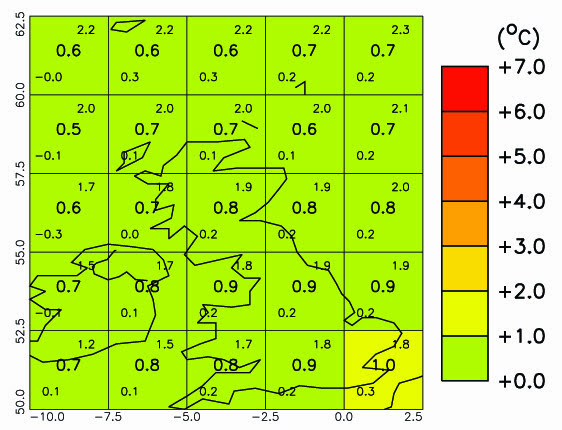
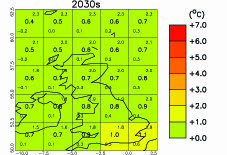


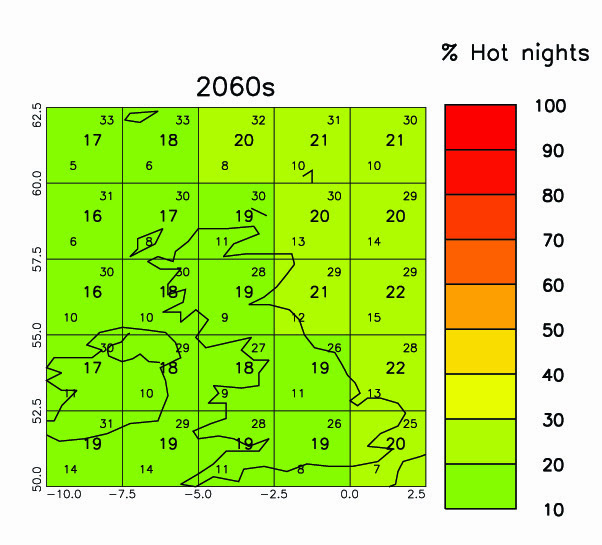

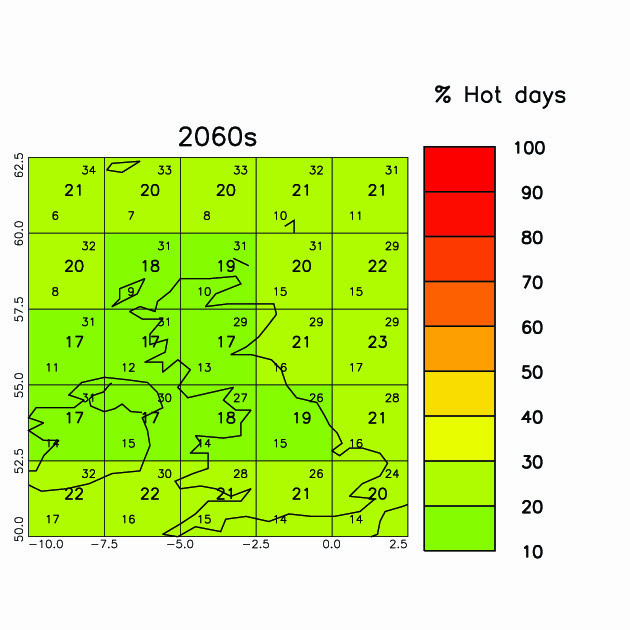
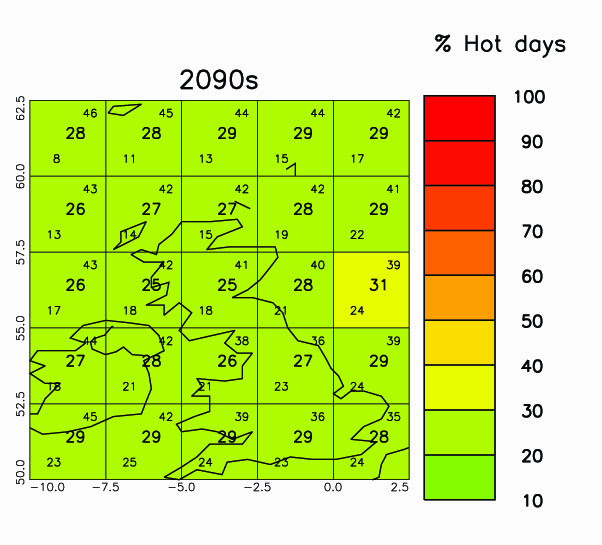



 The Climate Change Schools Resources were developed by the Climate Change Schools Project, based at the then Science Learning Centre in Durham and led by Krista McKinzey. A large number of teachers and schools in North East England were involved in their development.
The Climate Change Schools Resources were developed by the Climate Change Schools Project, based at the then Science Learning Centre in Durham and led by Krista McKinzey. A large number of teachers and schools in North East England were involved in their development.

